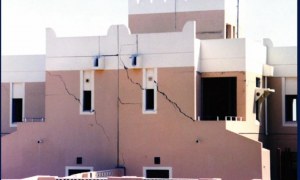🕑 Reading time: 1 minute
The bearing capacity of soil is influenced by many factors for instance soil strength, foundation width and depth, soil weight and surcharge, and spacing between foundations. These factors are related to the loads exerted on the soil and considerably affect the bearing capacity.
Apart from the above factors, there are number of non-load related factors that influence bearing capacity and need to be considered during the design of foundation and computing the soil bearing capacity. For instance, earthquake and dynamic motion, frost action, subsurface void, expansive and collapsible soil, potential heave, soil erosion and seepage, and soil reinforcement.
Bearing capacity is the ability of soil to safely carry the pressure placed on the soil from any engineered structure without undergoing a shear failure with accompanying large settlements.
Contents:
1. Soil Strength
Bearing capacity of cohesionless soil and mixed soil increases unproportionally with the increase of in the effective friction angle. However, bearing capacity of cohesive soil varies linearly with the soil cohesion provided that the effective friction angle is zero.

2. Foundation Width
Foundation width affects bearing capacity of cohesionless soil. The bearing capacity of a footing placed at the surface of cohesionless soil, where the soil shear strength is considerably dependent on internal friction, is proportional to the width of the foundation. Bearing capacity of cohesive soil of constant shear strength and infinite depth is independent of foundation width.
3. Foundation Depth
The greater the bearing capacity the deeper the foundation. This is specifically obvious in a uniform cohesionless soil. In contrary, if the foundation is carried down to a weak soil layer, then bearing capacity is declined.
Foundations placed at depths where the structural weight equals the weight of displaced soil usually assures adequate bearing capacity apart from the case where the structure supported by under-consolidated soil and collapsible soil subject to wetting.
4. Soil Weight and Surcharge
The contribution of subsurface and surcharge soil, which are influenced by water table, to the bearing capacity cannot be ignored. The water table should not be above the base of the foundation to avoid construction, seepage, and uplift problems. If the water table is below the depth of the failure surface, then it has no influence on the bearing capacity.

5. Spacing Between Foundations
It is recommended to consider minimum spacing between footings, which 1.5 times foundation width, during the design of foundation in order to avoid reduction in bearing capacity.
6. Earthquake and Dynamic Motion
Repeated movements could increase pore pressure in foundation soil and consequently bearing capacity is decreased. Sources of cyclic movements are earthquakes, vibrating machinery, and other sources like vehicular traffic, blasting, and pile driving.
The foundation soil can liquify when pore pressures equal or exceed the soil confining stress. Liquefaction reduces effective stress to zero and causes gross differential settlement of structures and loss of bearing capacity.

7. Frost Action
Frost heave in certain soils in contact with water and subject to freezing temperatures or loss of strength of frozen soil upon thawing can alter bearing capacity over time. Low cohesion materials containing a high percentage of silt-sized particle are mostly susceptible to frost action.
8. Subsurface Voids
Bearing capacity of soil decreases due to subsurface voids which are within a critical depth beneath the foundation. The critical depth is that depth below which the influence of pressure in the soil from the foundation is negligible.

9. Expansive and Collapsible Soils
Collapsible and expansive soil can have large strength and bearing capacity when they are fairly dry. However, the volume of these soils changes due to changes in water content. This leads to total and differential foundation movements. Seasonal wetting and drying cycles may cause soil movements that often lead to excessive long-term deterioration of structures with substantial accumulative damage.

10. Potential Heave
The potential heave can be determined from results of consolidometer test which can be performed in accordance with ASTM D 4546. The results of this test is considered in determining preparation of foundation soils to reduce destructive differential movements and to provide a foundation of sufficient capacity to withstand or isolate the expected soil heave.
11. Soil Reinforcement
Bearing capacity of soft or weak soil can be increased greatly by installing various forms of reinforcement in the soil like metal ties, strips, or grids, geotextile fabrics, or granular materials.

12. Soil Erosion and Seepage
Erosion of soil around and under foundations and seepage can reduce bearing capacity and can cause foundation failure.


